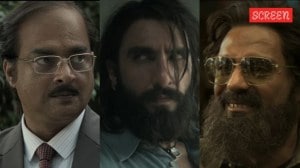When they talkedand failed
In 2004,11 Maoist leaders walked out of the jungles of Nallamalla in Andhra Pradesh,sat across the table in a government guesthouse and talked to representatives of the state government. But the talks failed when both sides stuck to their positions. With Maoists now showing an inclination for talks,SREENIVAS JANYALA looks back at those four days....
ON October 11,2004,11 Maoists walked out of the Nallamalla forest. Clad in camouflage fatigues,with rifles slung over their shoulders,they surveyed the men who had turned up to receive themgovernment officers,a large contingent of police and intelligence officers and mediapersons. The Maoists then handed over their arms to their comrades,who melted back into the forest. The Maoists,led by central committee member of the former CPI (ML) Akkiraju Haragopal,popularly known as Ramakrishna,were taking the first step towards initiating peace talks after the YS Rajasekhara Reddy government had guaranteed their safety.
But there was an air of suspicion and intrigue. The state government was on a strong footing. YSRs predecessor N. Chandrababu Naidu had crippled the Naxalites with successful police and commando operations in which many top leaders and most of the cadre had been eliminated. After sweeping to power in May 2004,YSR had kept up the pressure with Greyhounds,the anti-Naxal force,gaining the upper hand for the first time in the fight against Naxalites.
To some extent,the government believed the Naxalites agreed to the talks as a military and political strategy. They were losing leaders and cadres and had lost a lot of ground. They wanted to rearm and regroup and that opportunity would be provided with the ceasefire in place if talks were expected. On the other hand,they wanted to be seen as participating in a peace process, says an officer who advised the government on the talks.
Whatever the reasons,hope was in the air that October day. The government had announced a ceasefire from June 16,2004 for three months (later extended by another three months) and while there was disagreement over giving up of weapons,both sides were hopeful of a breakthrough.
Besides Ramakrishna,the other Naxal leaders who came for the talks were Amar,the state secretary of the CPI (ML)-Janashakti; Ganesh,a member of the North Telangana special zonal committee; Sudhakar,a member of the Andhra-Orissa border special zonal committee; and Riyaz,a Janashakti state committee member.
With two police jeeps escorting them,they travelled from Chinna Arutla near Srisailam in the Nallamalla forests to Guttikonda near Guntur. In the presence of local MLAs and police,they even addressed a large public gathering,with Ramakrishna,who had come out of the forest after 15 years,contributing to the myths and legends woven around Naxalites by talking at length about jungle life. One negotiator advised Ramakrishna to change from his uniform to casual clothes. He replied that he didnt have anything else to wear, says an official.
The government gave them word that they wouldnt be arrested or harmed as it did not want to jeopardise the talks, says Maoist lawyer KG Kannabiran,a member of the Committee of Concerned Citizens (CCC),which was instrumental in coaxing the Naxalites and the government to the table.
He recalls that while the first meeting was just to decide the agenda for the talks that followed,even to reach that stage it took more than two years of convincing and coaxing on both sides. The Maoists would put some conditions,the government would come up with some other and it always ended in a stalemate.
The committee of mediators finally prevailed,and it included,besides Kannabiran,retired IAS officer SR Sankaran,former journalist and editor of Andhra Prabha Potturi Venkateshwara Rao,civil rights activist G Haragopal,advocate Bojja Tarakam,and human rights activist K. Seshaiah.
All the Naxal leaders were accommodated as state guests at the Begumpet government guesthouse,where the talks took place over four days beginning October 15.
BRINGING THEM TO THE TABLE
It took a lot of backroom manoeuvering for the Naxals to agree to talks. Obviously,the Maoist leaders would not just walk out into the open. They did not suspect the then Andhra Pradesh home minister K. Jana Reddys intentions but they were not sure about YSR. So convincing them to come out was a hard task, says Kannabiran.
The Maoists were not convinced about the three-month ceasefire. They sent letters,delivered by anonymous couriers,to CCC that insisted that they should make sure the government ceasefire received wide publicity. CCC members met Jana Reddy several times and even insisted that he call up then DGP SR Sukumara in their presence and issue instructions to stop operations against Maoists.
We formed a team to ensure that the ceasefire got enough publicity and called up editors,journalists and all those involved in the talks. This instilled a sense of security among the Maoist leaders, says Sankaran.
But the mediators had problems of logistics. Like,how do you communicate daily developments to Maoists in their forest hideouts? This is where the mobile phone helped,says Sankaran. Confident that the state government would not violate the widely-publicised ceasefire,representatives of Maoist leaders camped on the fringes of the Nallamalla forests,where their cell phones were in signal range. Police later traced some of the phones to fictitious addressesthey were usually in the names of villagers who had no clue that a SIM card existed in their names.
By then,anti-Naxal operations had stopped but the mediators were worried about any stray incident that could put an end to their efforts. Normally,a patrol party deep in the forests or a Greyhounds platoon returning home would shoot first and ask questions later if they came across a well-armed group of Maoists camping at the edge of the forest, says Kannabiran.
Such close encounters did happen,where police officials refrained from acting. Warangal Polices anti-Naxal squad came face to face with two commanders of the CPI(ML) and an armed group near Mulugu but just turned around and went. In another instance,20 days before the talks,police located Riyaz alias Venkateshwarulu,who would have represented the CPI(ML) Janashakti in the peace talks,in Khammam district but aborted the operation. (Five months after the talks failed,on July 1,2005,Riyaz was shot dead in an alleged police encounter in Karimnagar district,not far from where he was spotted before the talks.)
On September 19,a month before the Maoist leaders came out of the forest,Kannabiran,Sankaran and other mediators went to the Nallamalla forests and met leaders of the CPI(ML)-PW and Ramakrishna,secretary of the Maoists AP State Committee. We immediately hit a block. The Maoist leaders maintained that state violence had to be countered by violence and submitted a long list of complaints against the police and government. We assured them that they could bring it up during the talks, he says.
AT THE TABLE
Principal mediator Sankaran says the preliminary discussions before the actual meeting held a lot of promise. However,within the first hour at the table,the talks hit a road block. It was soon evident that neither the group of Maoists nor the government was willing to yield an inch, Sankaran says.
Kannabiran,who was present throughout the preliminary talks,says,The Naxalites stuck to their stand insisting that the government first give some assurances. The government did not appear to take their suggestions seriously. The Naxal parties released a statement that the response from the government to the demands on tribal land,justice for backward classes,release of political prisoners,etc.,was vague and disappointing.
Naxalites also objected to the governments condition that they give up weapons before their demands were considered,arguing that armed struggle was their basic philosophy to ensure justice to the exploited sections. A joint statement by the leaders said,We are not asking for anything for ourselves. We only want the government to address peoples problems. We have nothing with us except the weapon and it will remain with us.
The Naxal parties also demanded a formal ceasefire agreement,which the government was uncomfortable with. After several rounds of discussions,Jana Reddy finally agreed to sign a letter agreeing to some ground rules akin to a ceasefire. Still there were problems because the government believed Naxalites should not carry or display arms during the ceasefire period when they visited villages. After much persuasion by mediators,the Naxal leaders agreed to this.
The second day of the talks centered on the Naxal demands to withdraw cases relating to public agitations,to scrap prizes announced for capture of leaders,to release political prisoners,and to control mafia and antisocial elements. The government issued a statement that it would drop cases where the charges were not severe,like cases against those who took part in pro-Naxal agitations. It also assured a review of Prevention of Terrorism Act (POTA) and Public Security Act cases slapped on Naxalites and sympathisers.
On October 18,the last day of the talks,the issue of land was discussed. The Naxal leaders contended that though land reform legislations had been enacted in 1972,only 5 per cent of the cultivable land had been redistributed till 2004. The government promised that a comprehensive land inventory would be compiled and a high-power committee would look into all aspects of land issue and control.
On October 20,the Naxal leaders went back to the forests from Chinna Arutla. Though the talks failed,it was a windfall for Intelligence officers. For the first time,we took photographs and videographed all of them. Till that time,we only had names and aliases of top leaders,but did not know what they looked like. We gathered a lot of information on them individually, an official says.
Four months later,on February 3,2005,Greyhounds cornered Ramakrishna and others in their hideout in the Nallamalla forests. Well aware that Ramakrishna had recently participated in talks with the government,the commandos held fire and contacted their higher-ups. Meanwhile,Ramakrishna called up Maoist sympathisers and emissaries like P Vara Vara Rao,Gaddar and Kalyan Rao and peace activists who,in turn,impressed upon the home minister to call off the operation or it would vitiate the atmosphere as the next round of talks was expected. The commandos left quietly.
POST-SCRIPT
HOWEVER,by then,the whiff of a solution had long dissipated. In fact,four days after the preliminary talks ended,on October 22,2004,YSR had given a hint of the same. He had reiterated that the Naxalites would have to lay down arms if talks were to progress and also called their claim that prime agricultural lands in and around Hyderabad had been encroached upon by industrialists absurd.
From then on,it was a downward spiral. Two weeks after the preliminary round of talks ended,hostilities had started again. On December 15,2004,Naxals struck in Visakhapatnam district,leaving four constables hurt. On January 6,a Naxalite of CPI (ML)-Janashakti was killed in a police encounter in Warangal district. On January 8,2005,a woman activist of Chaitanya Mahila Samakhya was killed in Prakasam district in an alleged encounter. On January 15,2005,six Maoists were killed in alleged encounters in Mahbubnagar and Prakasam districts. The Naxalites went on a killing spree,beheading informers and a village sarpanch.
On January 17,2005,CPI (Maoist) and CPI (ML)-Janashakti made a formal announcement withdrawing from the talks as a protest against combing operations and alleged encounters. More attacks and encounters followed and the government went back to its hard stance against the Naxalites. Having lost their hold on most of the districts,the rebels regrouped on the Andhra-Orissa border,where they are still trying to organise themselves.
- 01
- 02
- 03
- 04
- 05































